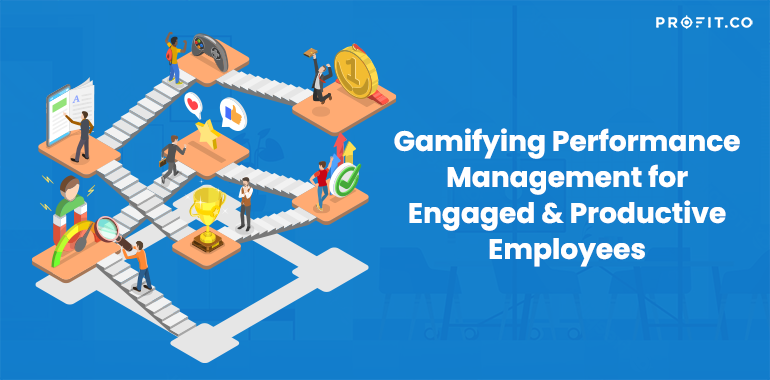Table of Contents
-
What is Gamification?
-
Time to Shake Up Performance Management
-
The Core Elements of Gamification
-
How to Gamify Performance Management in 10 Easy Steps?
-
Some Inspiring Gamification Examples to Improve Performance
-
Revenue Potential of Gamification in Employee Performance Management
-
Challenges and Limitations of Gamification
-
Conclusion
Performance management – the dreaded annual ritual filled with paperwork, forced smiles, and awkward feedback sessions. But what if there was a way to make it engaging, motivating, and fun?
The corporate world is buzzing with a revolutionary concept: Gamification.
It’s not just about making work fun; it’s about transforming mundane tasks into engaging quests. This innovative approach reshapes how we perceive performance management, morphing it from a dreaded annual review into an ongoing, exhilarating experience. Recently, gamification in performance management has gained the attention of IT managers everywhere. CISCO used gamification in call centers, reducing call time by 15% and improving sales by 8–12%
Imagine turning your team’s performance management into an exciting game how would that change their productivity and morale? Let’s dive into this intriguing world and discover how it’s changing the game for employees and managers alike.
What is Gamification?
According to Wikipedia, gamification is the strategic attempt to enhance systems, services, organizations, and activities by creating experiences similar to those experienced when playing games to motivate and engage users.
The essence of gamification is to add game-like characteristics to a non-game environment. The purpose is to increase engagement and create a more structured reward system emphasizing clear goals. It has been used in different environments, such as education, marketing, healthcare, and more. You can see health apps that give you rewards if you walk a certain distance each day or language apps that give you greater rewards the more words you learn. Game design is varied, but you are likely to see things like points, leaderboards, badges, and other accessories that encourage you to participate.
Research on gamification shows that most studies find it positively affects individuals, emphasizing that increasing motivation and participation makes it perfect for performance management.
The Psychology Behind Gamification
Gamification taps into the fundamental human desire for achievement, recognition, and progress. The brain releases dopamine, the “feel-good” neurotransmitter, when we achieve goals, receive rewards, and see our progress visualized. This translates to increased motivation, engagement, and, ultimately, better performance.
Time to Shake Up Performance Management
In the traditional performance management landscape, the focus has predominantly been on evaluating outcomes through formal and often rigid processes. This leads to potential stress and a need for more motivation among employees. According to Gartner, this outdated model is increasingly reconsidered as 81% of HR leaders seek to revamp their organization’s performance management systems to foster a more dynamic, engaging, and positive work environment.
The Core Elements of Gamification
The term “gamification” has become increasingly ubiquitous, but what are its core elements?
1. Points and Badges: These seemingly simple elements are powerful motivators. Points provide immediate feedback on progress, while badges visually recognize accomplishments. Imagine earning a “Top Contributor” badge for exceeding your sales quota!
2. Leaderboards: A healthy dose of friendly competition can be incredibly motivating. Leaderboards create a sense of community and encourage individuals to strive for higher achievements. Witnessing colleagues climb the ranks can inspire you to push your limits. For example, you could set different groups as teams and compete based on clients/ customers gained or revenue earned. This is also a great way to mix and match different types of people and compare how different strategies work. In the end, the various teams will have learnt from one another.
3. Challenges and Missions: Gamification thrives on well-defined challenges. These should be engaging, achievable, and aligned with overall goals. Completing a “Customer Satisfaction Champion” challenge could involve exceeding positive feedback metrics, leading to personal growth and improved customer service.
4. Progress Bars and Levels: Visualizing progress is key to sustained motivation. Progress bars offer a clear direction while leveling up unlocks new challenges and rewards. Think of it as climbing a mountain, each level offering a breathtaking new vista and exciting possibilities.
5. Feedback and Rewards: Continuous feedback is crucial for growth. Gamification integrates feedback seamlessly, ensuring individuals understand their strengths and areas for improvement. Rewarding big and small achievements reinforces positive behaviors and fuels further engagement. Points can also be awarded based on criteria such as creativity, outcomes, or teamwork. There is ample space to be flexible with setting up this reward system, but it should be made to encourage the skills you value most in your employees.
6. Avatars and Virtual Worlds: While only sometimes essential, avatars and virtual worlds can enhance the gamification experience. Imagine your avatar conquering challenges in a virtual office, collecting trophies, and unlocking new areas. This immersive experience can further boost motivation and engagement.
7. Narrative and Storytelling: Gamification benefits greatly from a compelling narrative. Weaving a story around the experience adds purpose and meaning, transforming tasks into parts of a larger journey. Imagine yourself as a valiant knight completing quests for the good of the kingdom (your company)!
Effective gamification goes beyond simply adding points and badges. It’s about understanding intrinsic motivators and creating a meaningful experience that aligns with individual and organizational goals. By effectively incorporating gamification into your performance management strategy, you gain a host of benefits, including
- Increased engagement
- Socialization through teamwork
- Data gathering
- Skill development
- Greater loyalty
- Real-time feedback
- Fresh with challenges
- Clear targets
- Transparency
However, is gamification effective when incorporated into the performance management system?
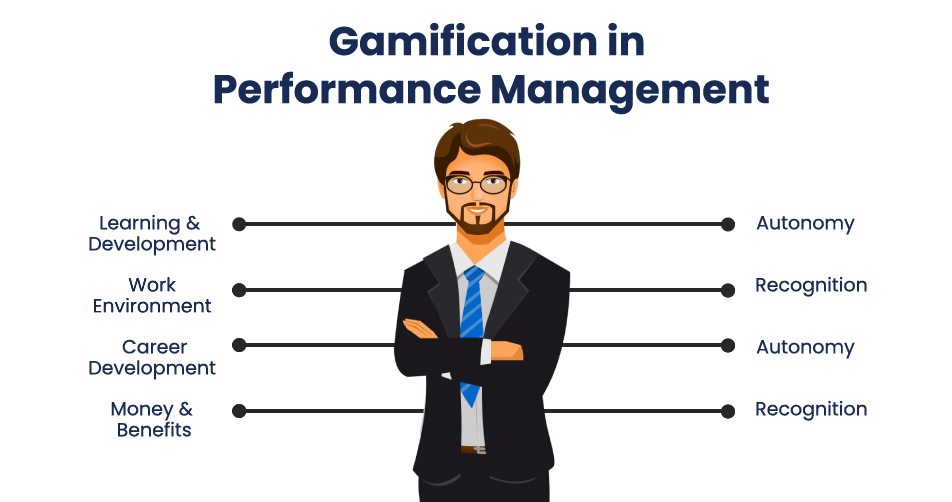
How to Gamify Performance Management in 10 Easy Steps?
1. Identify Objectives: Determine what you aim to achieve with gamification (e.g., increase sales, improve customer service, enhance learning and development) and ensure these goals align with your organizational strategy and culture.
2. Understand Your Audience: Consider the motivations, needs, expectations, and preferences of your employees and managers. Different groups may respond better to different types of gamification elements.
3. Choose Suitable Game Elements: Select gamification mechanics that best support your objectives and resonate with your audience. This could include points, badges, leaderboards, challenges, and feedback loops.
4. Align with Organizational Strategy: Ensure the gamified system complements your company’s strategy and culture. It should reinforce, not detract from, your core values and objectives.
5. Customize to Fit: Remember that there is no universal solution. Tailor your gamified performance management system to fit the unique context of your organization by considering factors like industry, team size, and company culture. and the people within it. For example, a playful approach might work well in a creative agency but not as well in a law firm.
6. Test and Iterate: Before full implementation, test the system with a small group to gather initial feedback and make necessary adjustments. Monitor participation rates and user interaction with the gamified elements to ensure active engagement. Make necessary adjustments to the gamified system based on feedback and data insights. This might involve tweaking game mechanics, altering rewards, or modifying challenges to suit participants’ needs better.
7. Collect Feedback: After rollout, continuously collect feedback and data from users and stakeholders to assess the system’s effectiveness and impact. Actively solicit and analyze feedback from users and stakeholders throughout the process. This includes quantitative data (e.g., engagement levels and performance metrics) and qualitative feedback (e.g., employee satisfaction surveys focus groups).
8. Evaluate and Refine: Use the feedback and data collected to evaluate the success of the gamification elements in meeting your objectives. Look for correlations between gamification elements and performance metrics. Identify which aspects are most engaging and which directly correlate with improved performance outcomes. Refine and adjust the system as needed to enhance its effectiveness.
9. Monitor Engagement: Keep an eye on how employees engage with the system. Measure the percentage of employees who complete gamified tasks or achieve certain milestones within the system. Monitor gamification strategy and its impact on their motivation and performance management experience. High levels of engagement can indicate a successful gamification strategy, whereas low engagement may require further adjustments.
10. Ensure Transparency: To foster trust and buy-in, the gamified system’s rules, progress tracking, and rewards are transparent to all participants. Create an equal opportunity to earn rewards. This means considering the organization’s diverse roles, responsibilities, and starting points. Consider creating a dedicated intranet page or digital resource hub.
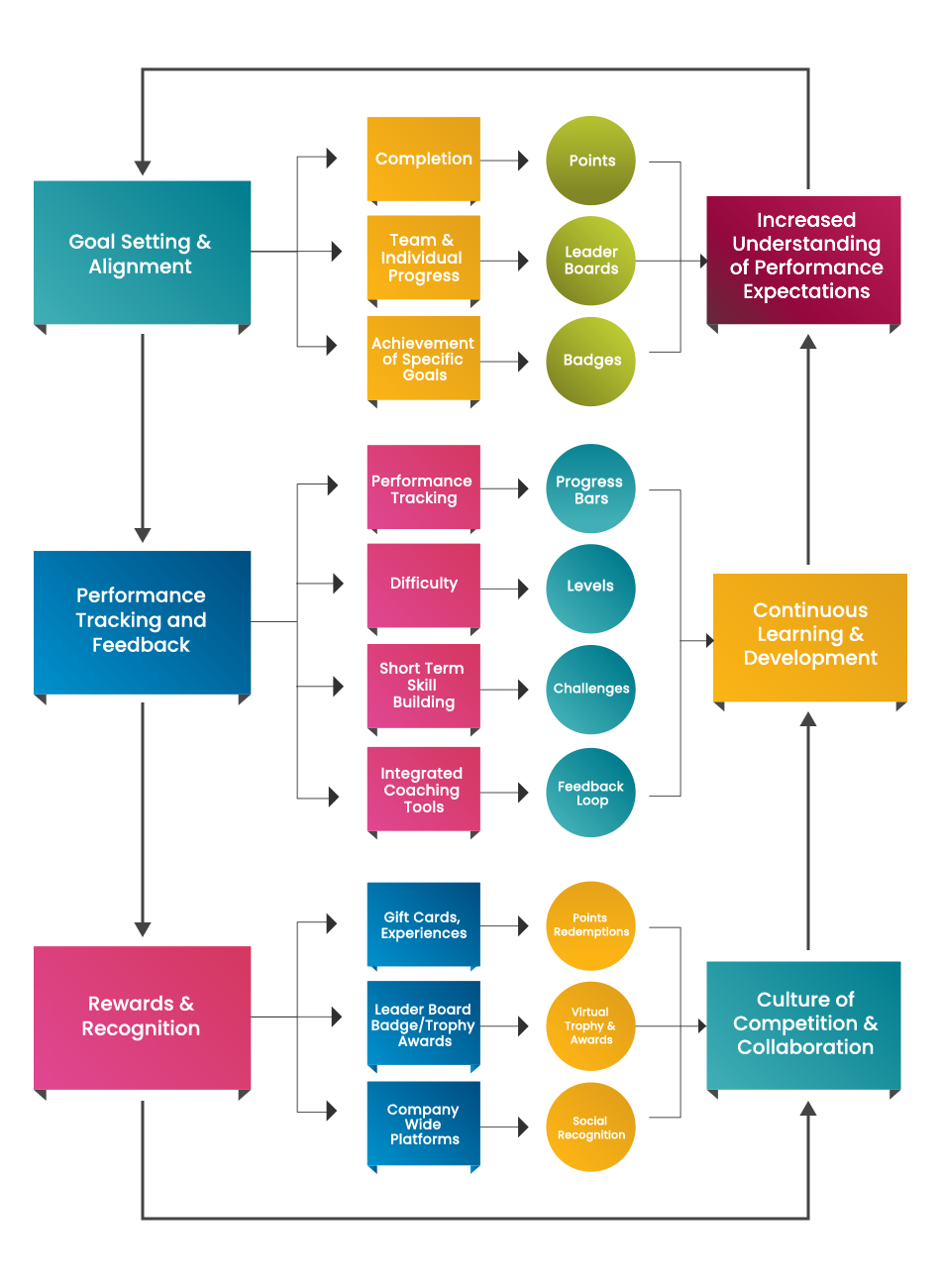
Some Inspiring Gamification Examples to Improve Performance
Microsoft Dynamics 365 for Sales: This sales management software incorporates gamification elements to boost sales performance. The “Gamified Coach” feature assigns challenges, tracks progress, and awards points for completing tasks like closing deals and exceeding quotas. Leaderboards foster healthy competition, while virtual trophies and badges recognize achievements. This gamification has led to a 15% increase in user engagement and a 10% improvement in sales productivity.
HP revolutionized sales training with The HP Uni App, developed in collaboration with Growth Engineering. This mobile app, focused on cybersecurity, used gamification to engage sales teams in a competitive league, offering ‘The HP Security Cup’ as an incentive. Custom microlearning modules suited to busy schedules led to extraordinary engagement: an average of 84 logins per user and 6.1 units completed, surpassing HP’s targets.
Learn more about achieving continuous learning for your organization with Profit.co today
The Future of Performance Management with Profit.co
Profit.co’s rewards and recognition platform can gamify performance management by transforming traditional tasks and objectives into an engaging and interactive employee experience. Profit.co’s comprehensive workspace management platform allows employees to gamify their OKRs with shared leaderboards and an interactive rewards program.
Using the Leaderboard option, you can monitor and record points distributed to and earned by employees within an organization, facilitating the identification of leaders. The Leaderboard tracks employee points, highlighting top performers and leaders within your organization. Real-time performance indicators help managers foster more team engagement.
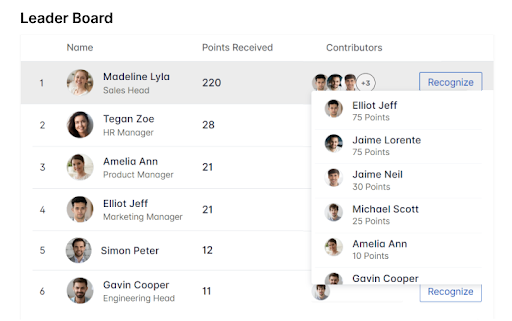
Elevate your team dynamics by actively participating in the exchange of ideas, offering recognition, and expressing appreciation for your colleagues. With the Rewards feature, you can monitor your points and activities and keep an eye on how others contribute to this vibrant culture of acknowledgment.
The reviewer can view the points earned by a particular user. For example, If a manager is performing an assessment, he will be able to view the total number of points earned by the employee to consider the points for rating.
This functionality allows for a transparent view of the rewards landscape, enabling you to see who recognizes whom and for what achievements, fostering a more connected and motivated team environment.
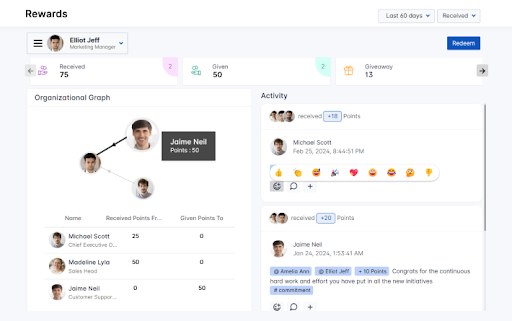
Revenue Potential of Gamification in Employee Performance Management
Gamification has emerged as a potent tool for driving revenue by enhancing employee performance management. Incorporating elements like points, badges, and leaderboards can significantly motivate employees, leading to goal achievement and productivity boosts. This, in turn, positively impacts a company’s financial success through increased sales, reduced operational costs, and enhanced customer satisfaction. Gamification also fosters a competitive yet healthy work environment, encouraging continuous improvement and profitability.
Additionally, recognizing employees’ efforts through gamification can improve retention rates, reducing costs related to recruitment and training.
Challenges and Limitations of Gamification
Gamification is all the rage in performance management. While it can be a real motivator, there are some pitfalls to watch out for.
First, some folks might feel like the whole thing’s a manipulative game like you’re trying to trick them into working harder. That’s why it’s super important to design your gamification system carefully, ensuring it fits your company’s values and goals. If it feels off, people will see right through it, and your performance reviews will be even more awkward than before.
Another thing to consider is don’t get so caught up in points and badges that you forget about the important stuff, like fair pay and learning opportunities. Gamification shouldn’t replace those things; it should make work more fun and engaging.
Of course, it’s not all doom and gloom. Gamification can boost your bottom line by getting people more motivated and productive. Think of increased sales, lower costs, and happier customers – pretty sweet, right? Plus, a little healthy competition can benefit everyone, pushing people to improve constantly. And let’s not forget that recognizing people’s efforts through gamification can keep them sticking around longer, saving you the hassle of hiring and training new folks.
So, gamification in performance management? It’s a double-edged sword. Done right, it can be a powerful tool. But if you’re not careful, it can backfire. The key is to understand your workforce, be patient, and remember that it’s not a silver bullet.
Conclusion
For any manager, gamification can be a great tool to change your workplace environment. It provides many benefits while providing a great range of customization for different preferences. Implementation is made a lot easier with the use of digital tools. Just as many games are played online today, you will find that it is easier to manage and track the progress of gamification in performance management if results are recorded online. An online platform also provides a space for sharing goals and objectives while allowing employees to interact with one another in an engaging gamified environment with a focus on employee engagement and development.
